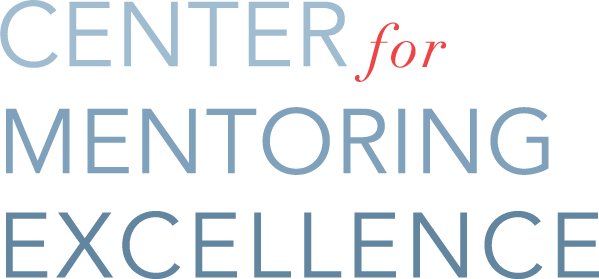by Center for Mentoring Excellence | May 5, 2013 | Uncategorized
Mentoring relationships are innately goal-centered partnerships. They are indispensable to the work of mentoring. Goals focus the work of mentoring, enable mentee growth and development, and, ultimately, determine the success of the relationship. Setting SMART — specific, measurable, action-oriented, realistic and timely—learning goals is one of the most daunting challenges mentors and mentees face.
Mentees are often reluctant to identify goals that appear too ambitious to a senior leader who, they fear, might not think the mentee capable of that level of achievement. Mentors find themselves tasked with making sure that goals will produce the kinds of tangible results that warrant time and energy and move the organization and mentee forward. Be SMART about helping your mentee set SMART goals! Here are some winning strategies for facilitating a mentee-driven goal setting process.
by Center for Mentoring Excellence | Mar 17, 2013 | Mentoring Relationships
Every mentee who participates in a mentoring program where matches are made for them hopes that their mentor will be a perfect match.
While some formal programs make the matches for mentees, many solicit mentee input or top choices before the final match is made. Some programs provide support and resources, but leave the sole discretion for mentor selection to the mentee.
The hope for a perfect match springs eternal. Whether you are responsible for pairing mentors and mentees, or looking for a mentor yourself, there are many criteria to consider. In this blog, we highlight four of them. These factors impact how a mentor and mentee relate to each other and affect the long-term success of the relationship.
1. Attitude and Values
Mentees report a greater level of satisfaction from their mentoring relationship when they share similar values and attitudes with their mentor. These points of connection, discovered early in the relationship, help the mentee and mentor bond and develop trust more quickly. Mentors connect more easily with a mentee who shares similar work values and attitudes (i.e. work ethic, focus on organizational benefit). On the flipside, having similar attitudes and values sometimes limits exposure to a diversity of perspectives. If mentor and mentee both share sensitivity to employee feelings, for example, there might not be as much gain in areas of accountability and conflict management.
2. Style
Style is the manner someone uses to influence others and convey information. It is sometimes used as a synonym for “personality.” Style is about “how” someone delivers a message. It is a strong determining factor in how someone is perceived regarding their approachability, intimidation, friendliness, or coolness. Style can play an overly important role in the selection of a mentor. While opposites can attract, that may not be the case at the beginning of a mentoring relationship. Style differences —soft or hard, informal or formal, head v. heart, left-brained or right-brained, optimistic or pessimistic—play out in the way the mentee receives feedback and support.
Similarity in style increases the mentee’s comfort and ease in navigating a new relationship. When the mentor and mentee share similar styles, a preference for analysis and detail, for example, the mentee is more likely to satisfy their mentor’s expectations. On the other hand, differences can produce significant learning for both mentor and mentee. The detailed-oriented, analytical mentee may be served better by a mentor with a more global, big picture perspective. A mentee who is conflict averse may benefit from a relationship with a mentor with a more direct style.
3. Learning Fit
Learning is the purpose of mentoring. It is why people engage in the relationship, what they do while they are in it, and what they want out of. Ultimately it is the learning fit that is important. Is there a match between what the mentee needs/wants to learn and what the mentor has to offer (experience, expertise, etc.)?
Mentors don’t have to be subject matter experts in the area the mentee is focused on, but they do have to understand the goals, challenges and requirements the mentee faces to ensure accountability for results. Recently, a mentor, the director of customer service, helped his mentee, the director of construction, learn how to improve his team’s engagement and ownership. Expertise and experience were aligned with the mentee’s goals and needs, not the mentee’s technical field.
4. Time
Good intention alone does not ensure good mentoring. Even when values, style and learning fit match perfectly, a mentoring relationship can be compromised when the mentor doesn’t have or make the time to commit to the partnership. Mentees look to mentors to act as sounding boards, encourage them to test out ideas, to “be there for them,” and provide a safety net. All of this requires regularly scheduled meetings, ad hoc availability for questions, occasional check-ins and a continuum of feedback. Time is the biggest challenge for busy mentors, but it is the glue that holds the relationship together. Most importantly, it sends an important message to the mentee: YOU matter.
by Center for Mentoring Excellence | Mar 13, 2013 | Making Mentoring Work For You
Confidentiality: A Slippery Slope
 Does the conversation that occurs between a mentor and mentee necessarily remain confidential during a time when the mentee is being considered for a career move? Or, when a leadership team sits to talk about whether to move someone who has been a mentee, can the mentor add to the conversation from his or her experience with the mentee? Or, is the conversation between the mentor and the mentee always strictly confidential?
Do you have any guidelines on this question? (more…)
Does the conversation that occurs between a mentor and mentee necessarily remain confidential during a time when the mentee is being considered for a career move? Or, when a leadership team sits to talk about whether to move someone who has been a mentee, can the mentor add to the conversation from his or her experience with the mentee? Or, is the conversation between the mentor and the mentee always strictly confidential?
Do you have any guidelines on this question? (more…)





